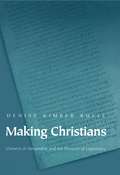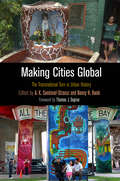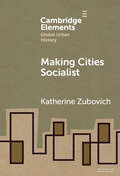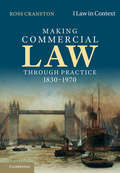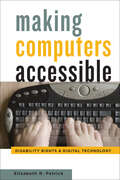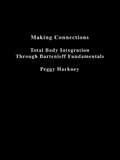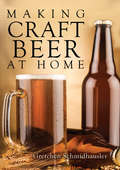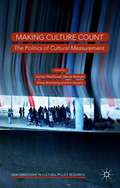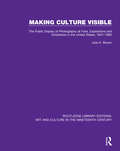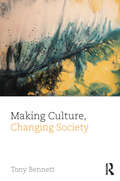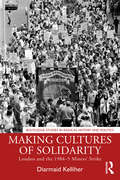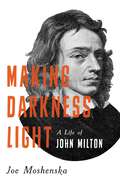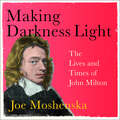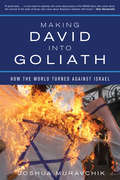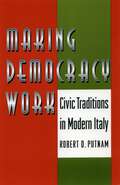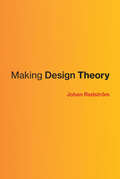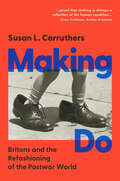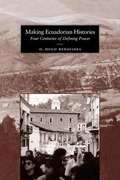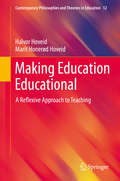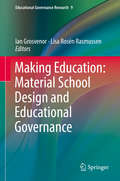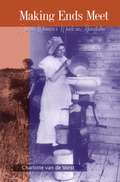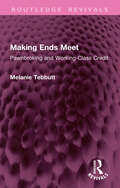- Table View
- List View
Making Christians: Clement of Alexandria and the Rhetoric of Legitimacy
by Denise Kimber BuellHow did second-century Christians vie with each other in seeking to produce an authoritative discourse of Christian identity? In this innovative book, Denise Buell argues that many early Christians deployed the metaphors of procreation and kinship in the struggle over claims to represent the truth of Christian interpretation, practice, and doctrine. In particular, she examines the intriguing works of the influential theologian Clement of Alexandria (ca. 150-210 c.e.), for whom cultural assumptions about procreation and kinship played an important role in defining which Christians have the proper authority to teach, and which kinds of knowledge are authentic. Buell argues that metaphors of procreation and kinship can serve to make power differentials appear natural. She shows that early Christian authors recognized this and often turned to such metaphors to mark their own positions as legitimate and marginalize others as false. Attention to the functions of this language offers a way out of the trap of reconstructing the development of early Christianity along the axes of "heresy" and "orthodoxy," while not denying that early Christians employed this binary. Ultimately, Buell argues, strategic use of kinship language encouraged conformity over diversity and had a long lasting effect both on Christian thought and on the historiography of early Christianity. Aperceptive and closely argued contribution to early Christian studies, Making Christians also branches out to the areas of kinship studies and the social construction of gender.
Making Cinelandia: American Films and Mexican Film Culture before the Golden Age
by Laura Isabel SernaIn the 1920s, as American films came to dominate Mexico's cinemas, many of its cultural and political elites feared that this "Yanqui invasion" would turn Mexico into a cultural vassal of the United States. In Making Cinelandia, Laura Isabel Serna contends that Hollywood films were not simply tools of cultural imperialism. Instead, they offered Mexicans on both sides of the border an imaginative and crucial means of participating in global modernity, even as these films and their producers and distributors frequently displayed anti-Mexican bias. Before the Golden Age of Mexican cinema, Mexican audiences used their encounters with American films to construct a national film culture. Drawing on extensive archival research, Serna explores the popular experience of cinemagoing from the perspective of exhibitors, cinema workers, journalists, censors, and fans, showing how Mexican audiences actively engaged with American films to identify more deeply with Mexico.
Making Cities Global: The Transnational Turn in Urban History
by Thomas J. Sugrue Nancy H. Kwak A. K. Sandoval-StrauszIn recent decades, hundreds of millions of people across the world have moved from rural areas to metropolitan regions, some of them crossing national borders on the way. While urbanization and globalization are proceeding with an intensity that seems unprecedented, these are only the most recent iterations of long-term transformations—cities have for centuries served as vital points of contact between different peoples, economies, and cultures. Making Cities Global explores the intertwined development of urbanization and globalization using a historical approach that demonstrates the many forms transnationalism has taken, each shaped by the circumstances of a particular time and place. It also emphasizes that globalization has not been persistent or automatic—many people have been as likely to resist or reject outside connections as to establish or embrace them.The essays in the collection revolve around three foundational themes. The first is an emphasis on connections among the United States, East and Southeast Asia, Latin America, and South Asia. Second, contributors ground their studies of globalization in the built environments and everyday interactions of the city, because even world-spanning practices must be understood as people experience them in their neighborhoods, workplaces, stores, and streets. Last is a fundamental concern with the role powerful empires and nation-states play in the emergence of globalizing and urbanizing processes.Making Cities Global argues that combining urban history with a transnational approach leads to a richer understanding of our increasingly interconnected world. In order to achieve prosperity, peace, and sustainability in metropolitan areas in the present and into the future, we must understand their historical origins and development.Contributors: Erica Allen-Kim, Leandro Benmergui, Matt Garcia, Richard Harris, Carola Hein, Nancy Kwak, Carl Nightingale, Amy C. Offner, Margaret O'Mara, Nikhil Rao, A. K. Sandoval-Strausz, Arijit Sen, Thomas J. Sugrue.
Making Cities Socialist (Elements in Global Urban History)
by Katherine ZubovichThis Element explores the history of urban planning, city building, and city life in the socialist world. It follows the global trajectories of architects, planners, and ideas about socialist urbanism developed during the twentieth century, while also highlighting features of everyday life in socialist cities. The Element opens with a section on the socialist city as it took shape first in the Soviet Union. Subsequent sections take a comparative and transnational approach to the history of socialist urbanism, tracing socialist city development in the Union of Soviet Socialist Republics (USSR), Eastern Europe, Asia, Africa, and Latin America.
Making Commercial Law through Practice 1830–1970: Law as Backcloth (Law in Context)
by Ross CranstonMaking Commercial Law Through Practice 1830–1970 adds a new dimension to the history of Britain's commerce, trade manufacturing and financial services, by showing how they have operated in law over the last one hundred and forty years. In the main law and lawyers were not the driving force; regulation was largely absent; and judges tended to accommodate commercial needs, so that market actors were able to shape the law through their practices. Using legal and historical scholarship, the author draws on archival sources previously unexploited for the study of commercial practice and the law's role in it. This book will stimulate parallel research in other subject areas of law. Modern commercial lawyers will learn a great deal about the current law from the story of its evolution, and economic and business historians will see how the world of commerce and trade operated in a legal context.
Making Computers Accessible: Disability Rights and Digital Technology
by Elizabeth R. PetrickThe revolution in accessible computer technology was fueled by disability activism, the interactive nature of personal computers, and changing public policy.In 1974, not long after developing the first universal optical character recognition technology, Raymond Kurzweil struck up a conversation with a blind man on a flight. Kurzweil explained that he was searching for a use for his new software. The blind man expressed interest: One of the frustrating obstacles that blind people grappled with, he said, was that no computer program could translate text into speech. Inspired by this chance meeting, Kurzweil decided that he must put his new innovation to work to "overcome this principal handicap of blindness." By 1976, he had built a working prototype, which he dubbed the Kurzweil Reading Machine.This type of innovation demonstrated the possibilities of computers to dramatically improve the lives of people living with disabilities. In Making Computers Accessible, Elizabeth R. Petrick tells the compelling story of how computer engineers and corporations gradually became aware of the need to make computers accessible for all people. Motivated by user feedback and prompted by legislation such as the Americans with Disabilities Act, which offered the promise of equal rights via technological accommodation, companies developed sophisticated computerized devices and software to bridge the accessibility gap. People with disabilities, Petrick argues, are paradigmatic computer users, demonstrating the personal computer’s potential to augment human abilities and provide for new forms of social, professional, and political participation. Bridging the history of technology, science and technology studies, and disability studies, this book traces the psychological, cultural, and economic evolution of a consumer culture aimed at individuals with disabilities, who increasingly rely on personal computers to make their lives richer and more interconnected.
Making Connections: Total Body Integration Through Bartenieff Fundamentals
by Peggy HackneyHuman movement influences an individual's perceptions and ability to interact with the world. Through exercises, illustrations, and detailed anatomical drawings, this remarkable book guides the reader toward total body integration. An experimental approach to movement fundamentals involving the patterning of connections in the body according to principles of efficient movement, the process of total body integration encourages personal expression and full psychological involvement.
Making Constitutions
by Gabriel L. NegrettoNegretto provides the first systematic explanation of the origins of constitutional designs from an analytical, historical and comparative perspective. Based on analysis of constitutional change in Latin America from 1900 to 2008 and four detailed case studies, Negretto shows the main determinants of constitutional choice are the past performance of constitutions in providing effective and legitimate instruments of government and the strategic interests of the actors who have influence over institutional selection. The book explains how governance problems shape the general guidelines for reform, while strategic calculations and power resources affect the selection of specific alternatives of design. It emphasizes the importance of events that trigger reform and the designers' level of electoral uncertainty for understanding the relative impact of short-term partisan interests on constitution writing. Negretto's study challenges predominant theories of institutional choice and paves the way for the development of a new research agenda on institutional change.
Making Craft Beer at Home
by Gretchen SchmidhauslerCraft beer has in recent years seen an unprecdented surge in popularity across the United States and Canada. Tired of mass-production beers, drinkers have gravitated toward hand-crafted, small-batch and often local beers and many devotees have even begun to brew their own. This comprehensive book, written by an experienced craft brewer, provides background, discusses the ingredients employed, explains what equipment is required and details the step-by-step "how to" of the brewing process. A perfect introduction to the world of craft-beer, Making Craft Beer at Home demystifies the art of home brewing while providing an historical perspective on America's love affair with the drink, and shows why this often exquisite refreshment has taken its places at the table alongside fine wines and liquors.
Making Culture Count: The Politics of Cultural Measurement (New Directions in Cultural Policy Research)
by Lachlan MacDowall Marnie Badham Emma Blomkamp Kim DunphyThis book is a collection of diverse essays by scholars, policy-makers and creative practitioners who explore the burgeoning field of cultural measurement and its political implications. Offering critical histories and creative frameworks, it presents new approaches to accounting for culture in local, national and international contexts.
Making Culture Visible: The Public Display of Photography at Fairs, Expositions and Exhibitions in the United States, 1847-1900 (Routledge Library Editions: Art and Culture in the Nineteenth Century #3)
by Julie K. BrownFirst published in 2001. Making Culture Visible provides a fresh focus on the history of nineteenth-century photography. The narrative moves from a close focus on several selected events between 1847 and 1900, beginning with six industrial fairs of the 1840s-1860s to the looming presence of the Philadelphia Centennial Exhibition in the mid-1870s. The last two chapters deal with the exhibition work of the Smithsonian Institution’s US National Museum in the 1880s and finally the collecting and displays of public libraries in the 1890s. The evolution of the increasingly complex social function of photography is clearly demonstrated.
Making Culture, Changing Society (CRESC)
by Tony BennettMaking Culture, Changing Society proposes a challenging new account of the relations between culture and society focused on how particular forms of cultural knowledge and expertise work on, order and transform society. Examining these forms of culture’s action on the social as aspects of a historically distinctive ensemble of cultural institutions, it considers the diverse ways in which culture has been produced and mobilised as a resource for governing populations. These concerns are illustrated in detailed case studies of how anthropological conceptions of the relations between race and culture have shaped – and been shaped by – the relationships between museums, fieldwork and governmental programmes in early twentieth-century France and Australia. These are complemented by a closely argued account of the relations between aesthetics and governance that, in contrast to conventional approaches, interprets the historical emergence of the autonomy of the aesthetic as vastly expanding the range of art’s social uses. In pursuing these concerns, particular attention is given to the role that the cultural disciplines have played in making up and distributing the freedoms through which modern forms of liberal government operate. An examination of the place that has been accorded habit as a route into the regulation of conduct within liberal social, cultural and political thought brings these questions into sharp focus. The book will be of interest to students and scholars of sociology, cultural studies, media studies, anthropology, museum and heritage studies, history, art history and cultural policy studies.
Making Cultures of Solidarity: London and the 1984–5 Miners’ Strike (Routledge Studies in Radical History and Politics)
by Diarmaid KelliherThis book combines radical history, critical geography, and political theory in an innovative history of the solidarity campaign in London during the 1984-5 miners’ strike. Thousands of people collected food and money, joined picket lines and demonstrations, organised meetings, travelled to mining areas, and hosted coalfield activists in their homes during the strike. The support campaign encompassed longstanding elements of the British labour movement as well as autonomously organised Black, lesbian and gay, and feminist support groups. This book shows how the solidarity of 1984-5 was rooted in the development of mutual relationships of support between the coalfields and the capital since the late 1960s. It argues that a culture of solidarity was developed through industrial and political struggles that brought together diverse activists from mining communities and London. The book also takes the story forward, exploring the aftermath of the miners’ strike and the complex legacies of the support movement up to the present day. This rich history provides a compelling example of how solidarity can cross geographical and social boundaries. This book is essential reading for students, scholars, and activists with an interest in left-wing politics and history.
Making Darkness Light: A Life of John Milton
by Joe MoshenskaAn innovative and elegant new biography of John Milton from an acclaimed Oxford professorJohn Milton was once essential reading for visionaries and revolutionaries, from William Blake to Ben Franklin. Now, however, he has become a literary institution—intimidating rather than inspiring.In Making Darkness Light, Oxford professor Joe Moshenska rediscovers a poet whose rich contradictions confound his monumental image. Immersing ourselves in the rhythms and textures of Milton&’s world, we move from the music of his childhood home to his encounter with Galileo in Florence into his idiosyncratic belief system and his strange, electrifying imagination.Making Darkness Light will change the way we think about Milton, the place of his writings in his life, and his life in history. It is also a book about Milton&’s place in our times: about our relationship with the Western canon, about why and how we read, and about what happens when we let someone else&’s ideas inflect our own.
Making Darkness Light: The Lives and Times of John Milton
by Joe MoshenskaFor most of us John Milton has been consigned to the dusty pantheon of English literature, a grim puritan, sightlessly dictating his great work to an amanuensis, removed from the real world in his contemplation of higher things. But dig a little deeper and you find an extraordinary and complicated human being.Revolutionary and apologist for regicide, writer of propaganda for Cromwell's regime, defender of the English people and passionate European, scholar and lover of music and the arts - Milton was all of these things and more.Making Darkness Light shows how these complexities and contradictions played out in Milton's fascination with oppositions - Heaven and Hell, light and dark, self and other - most famously in his epic poem Paradise Lost. It explores the way such brutal contrasts define us and obscure who we really are, as the author grapples with his own sense of identity and complex relationship with Milton. Retracing Milton's footsteps through seventeenth century London, Tuscany and the Marches, he vividly brings Milton's world to life and takes a fresh look at his key works and ideas around the nature of creativity, time and freedom of expression. He also illustrates the profound influence of Milton's work on writers from William Blake to Virginia Woolf, James Joyce to Jorge Luis Borges.This is an audiobook about Milton, that also speaks to why we read and what happens when we choose over time to let another's life and words enter our own. It will change the way you think about Milton forever.(P) 2021 Hodder & Stoughton Limited
Making David into Goliath
by Joshua MuravchikDuring the Six Day War of 1967, polls showed that Americans favored the Israelis over the Arabs by overwhelming margins. In Europe, support for Israel ran even higher. In the United Nations Security Council, a British resolution essentially gave Israel the terms of peace it sought and when the Arabs and their Soviet supporters tried to override the resolution in the General Assembly, they fell short of the necessary votes.Fast forward 40 years and Israel has become perhaps the most reviled country in the world. Although Americans have remained constant in their sympathy for the Jewish state, almost all of the rest of the world treats Israel as a pariah.What caused this remarkable turnabout? Making David into Goliath traces the process by which material pressures and intellectual fashions reshaped world opinion of Israel. Initially, terrorism, oil blackmail, and the sheer size of Arab and Muslim populations gave the world powerful inducements to back the Arab cause. Then, a prevalent new paradigm of Leftist orthodoxy, in which class struggle was supplanted by the noble struggles of people of color, created a lexicon of rationales for taking sides against Israel. Thus, nations can behave cravenly while striking a high-minded pose in aligning themselves on the Middle East conflict.
Making Democracy Work: Civic Traditions in Modern Italy
by Robert D. Putnam Robert Leonardi Raffaella Y. NanettiWhy do some democratic governments succeed and others fail? In a book that has received attention from policymakers and civic activists in America and around the world, Robert Putnam and his collaborators offer empirical evidence for the importance of "civic community" in developing successful institutions. Their focus is on a unique experiment begun in 1970 when Italy created new governments for each of its regions. After spending two decades analyzing the efficacy of these governments in such fields as agriculture, housing, and health services, they reveal patterns of associationism, trust, and cooperation that facilitate good governance and economic prosperity.
Making Design Theory (Design Thinking, Design Theory)
by Johan RedstromA new approach to theory development for practice-driven research, proposing that theory is something made in and through design.Tendencies toward “academization” of traditionally practice-based fields have forced design to articulate itself as an academic discipline, in theoretical terms. In this book, Johan Redström offers a new approach to theory development in design research–one that is driven by practice, experimentation, and making. Redström does not theorize from the outside, but explores the idea that, just as design research engages in the making of many different kinds of things, theory might well be one of those things it is making.Redström proposes that we consider theory not as stable and constant but as something unfolding—something acted as much as articulated, inherently fluid and transitional. Redström describes three ways in which theory, in particular formulating basic definitions, is made through design: the use of combinations of fluid terms to articulate issues; the definition of more complex concepts through practice; and combining sets of definitions made through design into “programs.” These are the building blocks for creating conceptual structures to support design. Design seems to thrive on the complexities arising from dichotomies: form and function, freedom and method, art and science. With his idea of transitional theory, Redström departs from the traditional academic imperative to pick a side—theory or practice, art or science. Doing so, he opens up something like a design space for theory development within design research.
Making Do: Britons and the Refashioning of the Postwar World
by Susan L. CarruthersImagine a world in which clothing wasn't superabundant – cheap, disposable, indestructible – but perishable, threadbare and chronically scarce. Eighty years ago, when World War II ended, a textile famine loomed. What would everyone wear as uniforms were discarded and soldiers returned home, Nazi camps were liberated, and millions of uprooted people struggled to subsist? In this richly textured history, Carruthers unpicks a familiar wartime motto, 'Make Do and Mend', to reveal how central fabric was to postwar Britain. Clothes and footwear supplied a currency with which some were rewarded, while others went without. Making Do moves from Britain's demob centres to liberated Belsen – from razed German cities to refugee camps and troopships – to uncover intimate ties between Britons and others bound together in new patterns of mutual need. Filled with original research and personal stories, Making Do illuminates how lives were refashioned after the most devastating war in human history.
Making Early Medieval Societies
by Kate Cooper Conrad Leyser Cooper, Kate and Leyser, ConradMaking Early Medieval Societies explores a fundamental question: what held the small- and large-scale communities of the late Roman and early medieval West together, at a time when the world seemed to be falling apart? Historians and anthropologists have traditionally asked parallel questions about the rise and fall of empires and how societies create a sense of belonging and social order in the absence of strong governmental institutions. This book draws on classic and more recent anthropologists' work to consider dispute settlement and conflict management during and after the end of the Roman Empire. Contributions range across the internecine rivalries of late Roman bishops, the marital disputes of warrior kings, and the tension between religious leaders and the unruly crowds in western Europe after the first millennium - all considering the mechanisms through which conflict could be harnessed as a force for social stability or an engine for social change.
Making Ecuadorian Histories: Four Centuries of Defining Power
by O. Hugo BenavidesIn Ecuador, as in all countries, archaeology and history play fundamental roles in defining national identity. Connecting with the prehistoric and historic pasts gives the modern state legitimacy and power.<P><P> But the state is not the only actor that lays claim to the country's archaeological patrimony, nor is its official history the only version of the story. Indigenous peoples are increasingly drawing on the past to claim their rights and standing in the modern Ecuadorian state, while the press tries to present a "neutral" version of history that will satisfy its various publics. <P> This pathfinding book investigates how archaeological knowledge is used for both maintaining and contesting nation-building and state-hegemony in Ecuador. Specifically, Hugo Benavides analyzes how the pre-Hispanic site of Cochasquí has become a source of competing narratives of Native American, Spanish, and Ecuadorian occupations, which serve the differing needs of the nation-state and different national populations at large. He also analyzes the Indian movement itself and the recent controversy over the final resting place for the traditional monolith of San Biritute. Offering a more nuanced view of the production of history than previous studies, Benavides demonstrates how both official and resistance narratives are constantly reproduced and embodied within the nation-state's dominant discourses.
Making Education Educational: A Reflexive Approach to Teaching (Contemporary Philosophies and Theories in Education #12)
by Halvor Hoveid Marit Honerød HoveidThis book is an argument for reflexivity in the act of teaching, which means to acknowledge that intention guides the act of teaching. Teaching must create attention towards processes of collectivity in the classroom. Today, teaching is both acts of expressing knowledge and acts of securing justice to all students through a mediation of knowledge. Teaching therefore expresses both knowledge with reference to school subjects, and justice according to the distribution of this knowledge.The authors argue for teaching as the driver of education. To pay attention to teaching is to pay attention to that which is inside the system of education. To consider education as a mediation of knowledge between generations, places teaching as an act of performing the content of education, in a class in a school. The complexity of these processes is easily overlooked when education is used as a means in competitive economies. The approach taken in this text is that deliberations about teaching must be based on historicity. The support for this argument builds on a reading of the French philosopher Paul Ricoeur.The book addresses teaching as an integral part of the learning process. In education today, everything seems to be concentrated around learning, as if teaching no longer takes place. Teachers and teacher educators need a language to discuss and understand teaching, both as personal and institutional actions. A Ricoeurian approach to a discussion on teaching as a reflexive and institutional practice, provides a timely approach to important questions related to teaching in our day and age.
Making Education: Material School Design and Educational Governance (Educational Governance Research #9)
by Ian Grosvenor Lisa Rosén RasmussenThis book brings together the notions of material school design and educational governance in the first such text to address this critical interrelationship in any depth. In addressing the issue of governance through analysing current and historical material school designs, it looks at the intersection of politics, economics, aesthetics and pedagogical ideas and practices. More specifically, it explores and unfolds educational governance as it is constituted, materialized and transformed in and through material school designs. It does so by studying a range of issues: from the material and aesthetic language of schooling to the design of the built environment, from spatial organization to the furnishing and equipment of classrooms, and from technologies of regulation to the incorporation of tools of learning. The book presents examples from Europe, Latin and Central America and the United States, and relates to the past, present and future of governance and school design. It focuses on design processes and on designers/architects and people involved in the planning of school design, as well as on school leaders, teachers and pupils adopting, inhabiting and re-shaping them in everyday school life. Furthermore, the book discusses how to study governance by material school design, and how to act upon governance by material design on wishful, actual and ethical terms.
Making Ends Meet: Farm Women's Work in Manitoba
by Charlotte van de VorstBased on hundreds of interviews with Manitoba farm men and women, Making Ends Meet reconstructs the common history shared by modern farm women as well as by their mothers and grandmothers. It explores women's changing roles on the farm, from the early days of the Red River settlement to the twentieth-century farm community. The women's own stories reveal their ingenuity and tenacity in "making ends meet" through economies, shared, labour, and generation of new resource income as varied as raising poultry and custom woodworking. These stories prove that the contributions of farm women have been vital in establishing and maintaining the family farm, and are critical to its continued survival.
Making Ends Meet: Pawnbroking and Working-Class Credit (Routledge Revivals)
by Melanie TebbuttOriginally published in 1983, this book filled a gap in the existing literature, because the effect of credit upon a family’s real income was frequently omitted in studies of living standards. The book highlights daily routines and relationships which would otherwise remain hidden, using interviews with pawnbrokers, credit personnel and their customers in the Manchester and Salford areas of the UK. These supplement unusual documentary sources such as pledge records from the inter-war years which suggest how sensitive a barometer the trade was of working-class poverty or prosperity.The pawnshop epitomized the economic dependence of women, whose critical role in domestic management and credit organization is a key theme. Yet indebtedness became the fulfilment of a damning sexual stereotype. Insecurity of income and the physical conditions of life combined to produce a distinct set of values, of which pawning was a central part. At a time when the cost-of-living crisis is affecting the global population, and pawnbroking in the UK is on the increase, this book has an enduring relevance.
